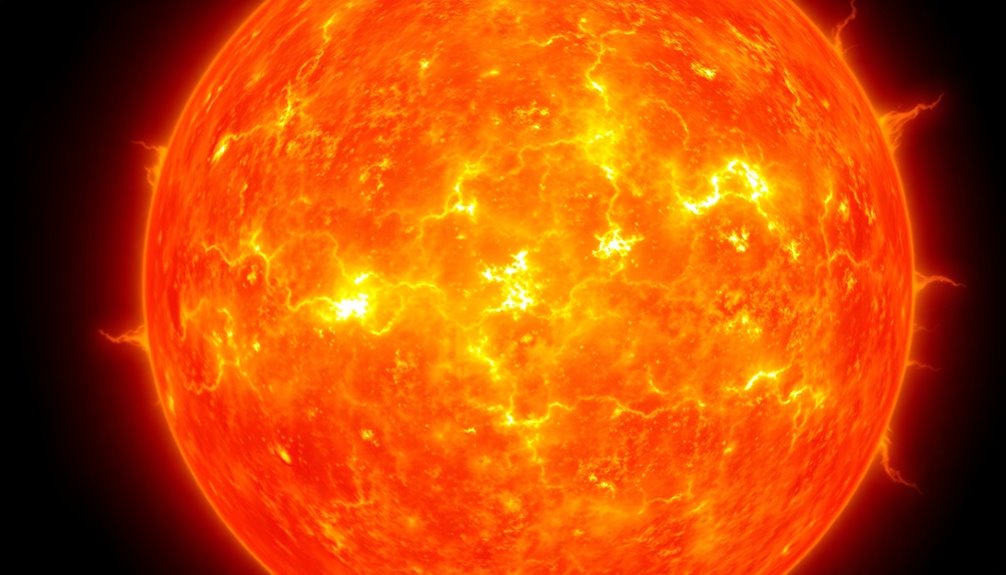The Sun is the brightest daytime star, boasting an apparent magnitude of -26.74, which makes it 13 billion times brighter than Sirius. Its glory comes from the immense energy produced through nuclear fusion, where hydrogen atoms collide to form helium, releasing staggering power. Brightness fluctuations occur due to sunspots and solar cycles that shift every 11 years, affecting its luminosity. You experience its energy daily, influencing everything from climate to photosynthesis. The interplay of magnetic fields and plasma currents contributes to its dynamic appearance. Curious about how these factors shape our view of the Sun? You'll find more intriguing details ahead.
Key Takeaways
- The Sun's apparent magnitude of −26.74 makes it the brightest object in the sky, vastly outshining other stars like Sirius.
- Brightness fluctuations are influenced by magnetic fields, plasma currents, and granulation patterns on the Sun's surface.
- The solar cycle, lasting about 11 years, affects sunspot activity and consequently influences solar brightness and space weather.
- Approximately 80,000 x 10^12 watts of the Sun's energy reach Earth daily, sustaining life and influencing climate.
- The Sun's energy is generated through nuclear fusion, converting about 4 billion kg of matter into energy each second.
Causes of Brightness Fluctuations

While exploring the Sun's brightness, you'll find that fluctuations stem from two primary causes: magnetic fields and plasma currents.
Magnetic fields create observable features like sunspots and faculae, where darker spots indicate cooler areas and brighter regions signify intense activity. These magnetic structures lead to slower brightness changes over time scales longer than five hours. Additionally, brightness variations caused by these magnetic activities can span from minutes to decades.
On the other hand, plasma currents play a vital role in rapid fluctuations. Hot plasma rises, creating a dynamic pattern called granulation, which causes brightness shifts in less than five hours. As this plasma cools and descends, it further contributes to the Sun's ever-changing luminosity.
Together, these factors create a fascinating interplay that affects how we perceive our daytime star.
The Solar Cycle Explained

The solar cycle, which spans about 11 years, showcases the dynamic nature of our Sun as it undergoes alternating phases of solar activity.
During this cycle, you'll notice fluctuations in the number of sunspots, with solar maximum featuring the highest count and solar minimum showing the lowest. Historical records of sunspots exist for over a thousand years, providing valuable insight into the long-term behavior of solar activity.
Each cycle also includes a complete flip of the Sun's magnetic field, reversing the north and south poles. This magnetic transformation ties into the Sun's intense magnetic activity, creating sunspots that can last from hours to months.
As sunspots peak, expect increased solar flares and coronal mass ejections, impacting space weather and our technology.
Understanding this cycle helps predict potential effects on Earth, ensuring we're prepared for solar-related disruptions.
Energy Output and Distance

Understanding the Sun's energy output is crucial, especially since it affects life on Earth and drives our climate. The Sun generates about 3.94 x 10^23 kW daily, with a staggering total energy emission of approximately 3.846 x 10^26 watts per second. However, only around 80,000 x 10^12 watts reach Earth's surface, which is still 10,000 times our current global energy demand. This energy arises from hydrogen atoms colliding and forming helium, releasing heat in the process. Moreover, the Sun's composition of hydrogen plays a significant role in the continuous production of energy as these atoms collide and fuse. As energy travels, it takes about 8 minutes to reach you from the Sun, delivering around 1,361 watts per square meter. The intensity of this energy decreases with distance, impacting temperatures on planets and overall climate dynamics.
Observable Patterns and Effects

As Earth spins on its axis and orbits the Sun, you can observe fascinating patterns that shape daily life and the changing seasons.
Day and night cycles emerge from this rotation, marking the rhythm of our lives. You'll notice how shadows shift in length and direction, reflecting the Sun's position in the sky. At different times of day, month, and year, the positions of the Sun and stars reveal themselves, creating a dynamic celestial map. This tilt of Earth's axis not only gives rise to seasonal changes but also affects which stars are visible at night.
Interestingly, the Sun appears brighter than other stars because of its proximity to Earth, which significantly influences our perception of its brightness.
As you experience noon and midnight, remember that these observable patterns are fundamental to understanding our planet's relationship with the Sun.
Brightness and Visibility

Observing the patterns of the Sun not only reveals its movement across the sky but also highlights its incredible brightness and visibility.
With an apparent magnitude of −26.74, the Sun stands as the brightest object in our sky, outshining even the next brightest star, Sirius, by about 13 billion times. This immense brightness is vital for life on Earth, powering photosynthesis and influencing our climate. The Sun's energy output, which converts approximately 4 billion kg of matter into energy per second, is fundamental to sustaining life on our planet.
However, factors like atmospheric conditions, the Sun's angle due to Earth's tilt, and its elliptical orbit can affect how well you see it.
Solar Structure and Activity

The Sun, a colossal ball of hot plasma, is structured in layers that play crucial roles in its functionality and activity.
At its core, nuclear fusion occurs at staggering temperatures of about 15.7 million Kelvin, fusing hydrogen into helium. Above this, the radiative zone carries energy outward through radiation, while the convective zone transfers energy by convection. The core extends from the center to approximately 138,000 km and is essential for the Sun's energy production.
The visible photosphere showcases sunspots and granules. Layered above, the chromosphere and corona reach extreme temperatures, influencing solar phenomena like solar flares and coronal mass ejections.
The Sun's magnetic activity follows an 11-year cycle, marked by solar maximums and minimums, impacting space weather.
This dynamic structure ensures the Sun remains a vibrant and essential force in our solar system.
Frequently Asked Questions
How Does the Sun's Brightness Affect Climate on Earth?
The Sun's brightness affects Earth's climate primarily through variations in solar irradiance.
You'll notice that during solar maximum, the increased UV radiation can warm the stratosphere, altering circulation patterns that influence weather.
Although the overall change in solar energy is small, feedback mechanisms enhance these effects, leading to noticeable temperature shifts.
However, keep in mind that recent rapid warming trends are largely due to human activities, not just solar changes.
What Would Happen if the Sun's Brightness Suddenly Increased?
If the Sun's brightness suddenly increased, you'd likely notice a significant rise in global temperatures.
This could lead to more intense heatwaves and altered weather patterns. Ecosystems would shift, as liquid water becomes more abundant, impacting both plants and animals.
You might also experience stronger UV radiation, which could harm living organisms.
Additionally, renewable energy production could surge, making solar power an even more viable option for meeting energy needs.
How Do Solar Flares Impact Earth's Atmosphere?
Solar flares significantly impact Earth's atmosphere by releasing intense radiation that heats and ionizes the upper atmosphere, particularly the ionosphere.
This can disrupt your GPS signals and short-wave radio communications, causing sudden disturbances. Additionally, the increased drag on satellites in low Earth orbit could lead to orbital decay.
During geomagnetic storms triggered by solar flares, you might even see auroras appearing closer to the equator than usual, showcasing the event's reach.
Can the Sun's Brightness Change Over Shorter Time Scales?
Yes, the Sun's brightness can change over shorter time scales.
You'll notice that granulation, caused by rising and sinking plasma, creates rapid fluctuations in brightness, often within less than five hours.
Additionally, magnetic fields generate sunspots and faculae, leading to variations that can affect how bright the Sun appears.
These changes, while subtle, play a significant role in influencing the Sun's overall brightness and its impact on Earth's climate.
What Instruments Measure the Sun's Brightness Accurately?
To measure the sun's brightness accurately, you can use instruments like pyranometers, which capture total solar radiation, or pyrheliometers, designed for direct sunlight.
Spectroradiometers provide detailed spectral data across wavelengths, while portable solar power meters offer quick and precise readings of sunlight intensity.
Each instrument serves a unique purpose, so choose one based on your specific needs, whether it's for research, solar energy assessments, or agricultural studies.
Conclusion
In conclusion, the sun's brightness isn't just a constant; it's a dynamic dance influenced by solar cycles, energy output, and our distance from this giant star. By understanding these fluctuations and their observable effects, you gain a deeper appreciation for the sun's glory. So next time you bask in its light, remember the intricate structures and activities at play. The sun, with all its brilliance, is a testament to the wonders of our universe.









